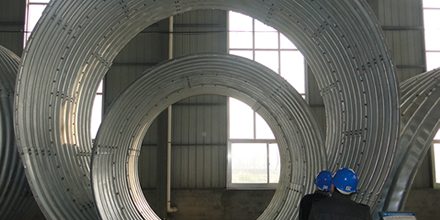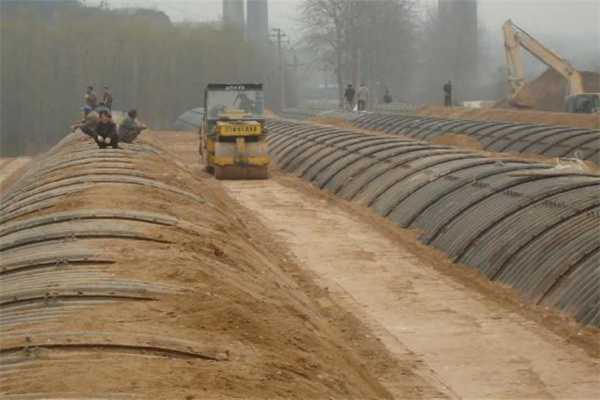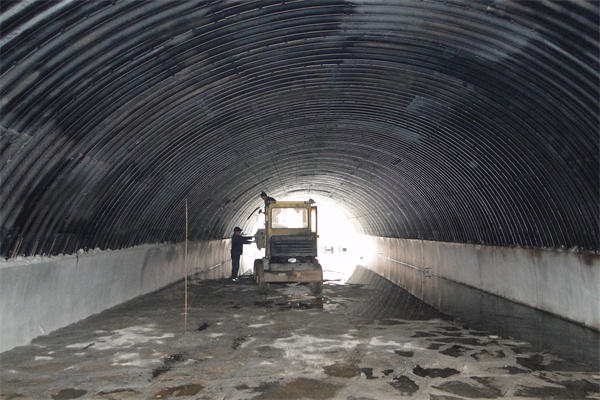Steel corrugated pipe culvert on construction site
The application of corrugated pipe culverts on the China Nepal Highway
The China Nepal Highway starts from Lhasa, the capital of the Xizang Autonomous Region, in the east and ends at the Friendship Bridge at China's Zhangmu Port in the south, with a total length of about 756km, only 80km from Kathmandu, the capital of Nepal. In the 31.1km permafrost sections of the China Nepal Highway, the accumulated length of the road surface section with heavy frost heave and saliva flowing ice on the roadbed is 21.3km, and the total length of the damaged section is 26.4km, accounting for 84.9% of the total length of these two sections of the highway. There are a total of 72 bridges and culverts in these two sections of the road, with 66 bridges and culverts experiencing varying degrees of damage, accounting for 91.7% of the existing bridges and culverts.
A total of 23 corrugated pipe culverts with a diameter of 1.5-2.0m were designed for the Jiacuola Mountain Crossing Line in this renovation design. Corrugated pipe culverts have the characteristic of strong adaptability to deformation. Therefore, fully utilizing the superior performance of metal corrugated pipe culverts in tension, shear resistance, and deformation adaptation is one of the necessary engineering measures, to ensure the lateral drainage and stability of roadbed in permafrost areas. In addition, corrugated pipe culverts have the advantages of light weight, convenient transportation, simple construction, short construction period, and low cost. And it Effectively reducing the cost of culvert engineering in permafrost areas. After economic analysis, the cost of each corrugated pipe culvert project is about 60% of that of a reinforced concrete slab culvert with the same aperture. The practical use of metal corrugated pipe culverts in the Qinghai Tibet Highway and permafrost regions abroad has shown that during the roadbed usage period, there is basically no damage phenomenon of freeze-thaw fatigue and excessive deformation of metal corrugated pipe culverts.
Design of corrugated pipe culvert
The design process of corrugated pipe culverts is to determine the allowable compressive stress by calculating the load acting on the pipe surface, and then select the parameters of the culvert that can meet this requirement, including wavelength, wave height, pipe thickness, pipe diameter, etc. The factors that should be considered in the design of corrugated pipe culverts can be summarized as follows:
Before design, on-site investigation should be carried out to investigate the engineering geological characteristics and local hydrological conditions of the layout site. The cost of construction and maintenance after completion should also be minimized;Determine the structure, size, shape, alignment, and slope of the culvert based on hydrological conditions and other service requirements such as hydraulics;/p>
The strength of the structure can meet the pressure generated by the embankment and live load, while also resisting the erosion of water flow;
Choose appropriate anti-corrosion materials and processes to prevent significant wear and corrosion in the culvert.
The design of corrugated pipe culverts includes the following processes
Determination of aperture,The aperture and specification parameters for selecting metal corrugated culvert pipes: The main pipe section of the metal corrugated culvert pipe is set at 0.5-3.5m per section, and angle steel flanges are added between the pipe sections for connection.
Determination of the minimum filling thickness for the top of metal corrugated pipe culverts, The minimum filling thickness of the top of the metal corrugated pipe culvert is related to the pipe diameter and live load size. The larger the pipe diameter and live load, the greater the minimum filling thickness. The minimum filling thickness should generally not be less than 50cm.
Conclusion
Corrugated pipe culverts have advantages such as light weight, convenient transportation, simple construction, short construction period, and good deformation resistance. They are more suitable for cold area projects such as the China Nepal Highway than reinforced concrete slab culverts.
 Products
Products Application
Application



